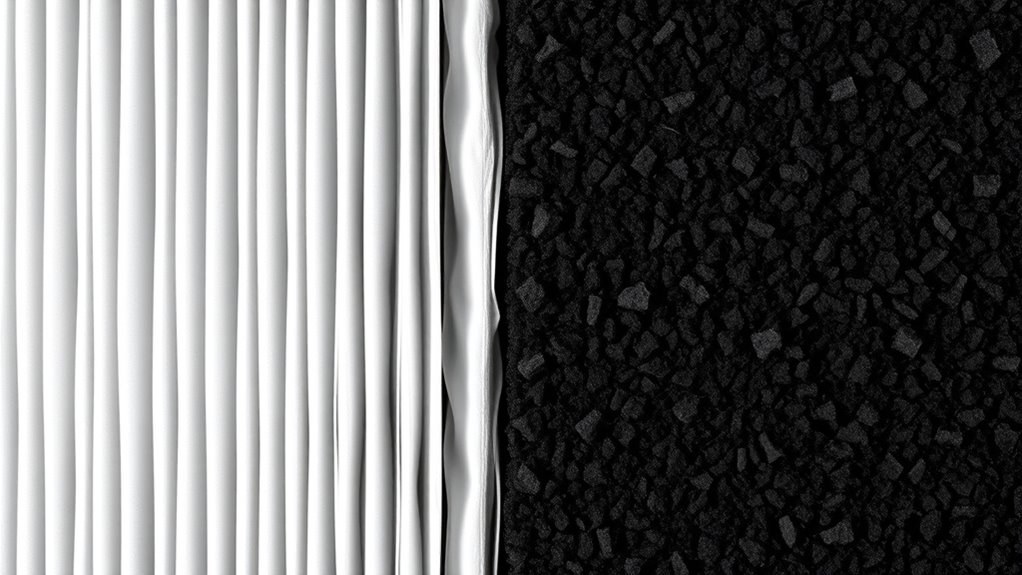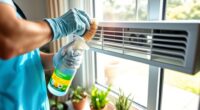HEPA filters capture airborne particles like dust, pollen, pet dander, and bacteria through physical mechanisms such as impaction, interception, and diffusion. Activated carbon filters adsorb gases, odors, and VOCs on their porous surfaces. To keep your air purifier effective, replace HEPA filters every 6-12 months and carbon filters every 3-6 months. Combining both filters offers thorough air cleaning. Discover how to optimize your setup and maintain your filters for the best indoor air quality.
Key Takeaways
- HEPA filters trap solid particles like dust, pollen, and viruses, providing comprehensive particulate removal.
- Activated carbon filters adsorb gases, odors, and chemical pollutants, targeting gaseous indoor contaminants.
- Combining HEPA and carbon filters offers balanced filtration for both particulates and gaseous pollutants.
- Proper maintenance involves regular replacement: HEPA filters last 6-12 months, carbon filters every 3-6 months.
- Regeneration methods for activated carbon include thermal, water, or chemical processes to restore adsorption capacity.
How HEPA Filters Capture Particulate Matter
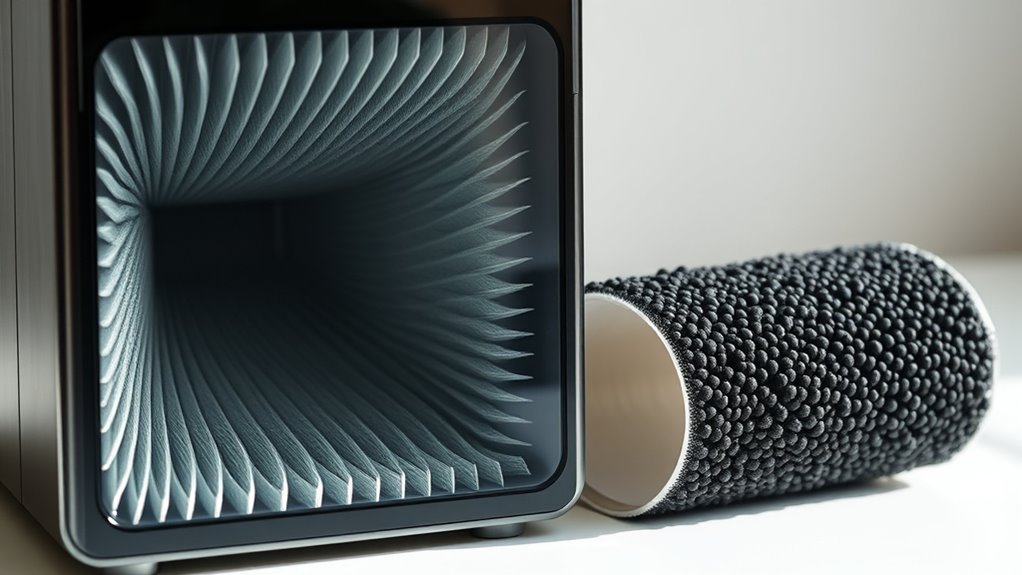
HEPA filters capture particulate matter through several mechanisms that work together to trap airborne particles effectively. Impaction occurs when larger particles collide with fibers and get stuck, especially at higher airflow speeds. Interception happens when medium-sized particles follow airflow lines and adhere to fibers due to proximity. Diffusion involves tiny particles bouncing off gas molecules, increasing the chance they’ll hit a fiber. Inertial deposition occurs when particles with mass can’t follow rapid airflow changes and settle onto fibers. Some filters also use electrostatic attraction—charged fibers draw in particles, boosting efficiency. HEPA filters trap 99.97% of particles as small as 0.3 microns, including dust, pollen, pet dander, mold spores, and some bacteria and viruses. These combined mechanisms make HEPA filters highly effective at improving indoor air quality. Additionally, understanding filter maintenance is crucial to ensure ongoing performance and effectiveness over time, as a well-maintained filter maintains optimal filtration efficiency.
The Gas and Odor Adsorption Capabilities of Activated Carbon
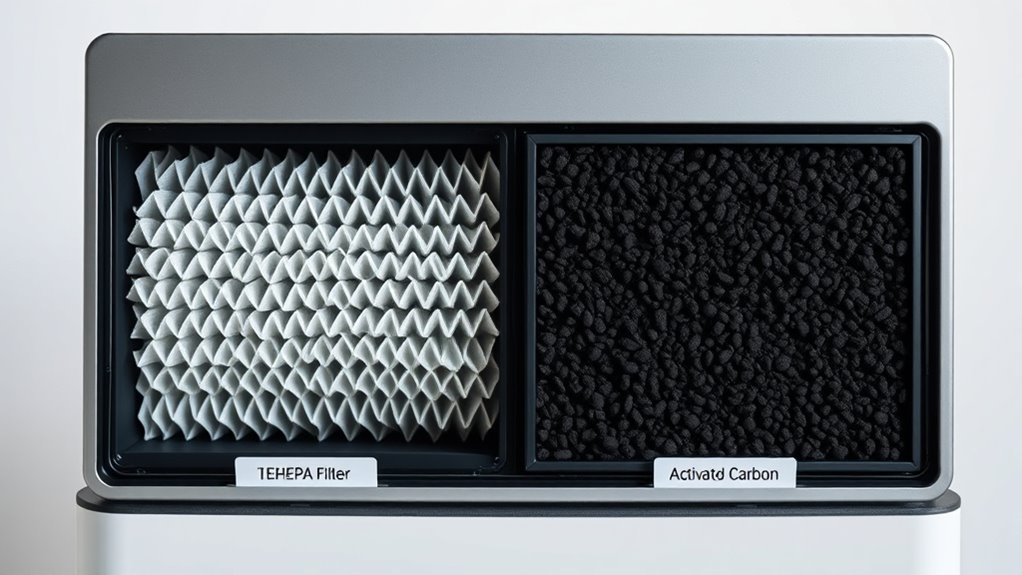
Activated carbon’s large surface area is key to its ability to trap gases and odors effectively. Different pollutants, such as VOCs, ammonia, and methane, interact uniquely with the porous structure, affecting how well they’re adsorbed. When the filter becomes saturated, regeneration methods like heating or purging help restore its adsorption capacity and prolong its use. Additionally, sustainable building materials in tiny houses can enhance the eco-friendliness of air filtration systems used within these spaces. Incorporating eco-friendly materials into filter design can further reduce environmental impact and promote sustainability.
Surface Area Importance
Have you ever wondered why some air purifiers effectively remove odors and gases while others don’t? It all comes down to surface area. Activated carbon’s effectiveness depends heavily on its large, convoluted microporous structure, which provides up to 3000 m²/g of surface area. This vast surface allows more adsorption sites, increasing capacity for gases and odors. Micropores enable multiple simultaneous interactions, boosting efficiency. The pore volume, typically between 0.3 to 0.8 cm³/g, further enhances gas retention. The greater the surface area, the faster and more thoroughly gases and odors are adsorbed. Variations in pore structure, based on production methods, influence how well the carbon captures specific compounds. In essence, a larger surface area means better adsorption performance, making it a key factor in choosing activated carbon for air purification. Additionally, vetted manufacturing processes ensure the quality and consistency of activated carbon’s pore structure, further optimizing its adsorption capabilities. Understanding how pore structure influences performance can help consumers select the most effective filters for their needs.
Types of Gaseous Pollutants
Ever wonder how activated carbon effectively captures a wide range of gaseous pollutants and odors? It does so through its porous structure, which provides a large surface area for adsorption. Gases like sulfur dioxide (SO2) from burning fossil fuels react with carbon, trapping the molecules and reducing their presence. Activated carbon also adsorbs nitrogen oxides (NOx), volatile organic compounds (VOCs), and hazardous air pollutants like benzene, preventing them from lingering in the air. Ozone, a secondary oxidizing gas, can also be reduced by activated carbon, though less efficiently. This capability makes activated carbon highly effective against a variety of harmful gases and unpleasant odors, helping improve indoor air quality. Its adsorptive power depends on pore size, surface area, and the nature of the pollutants.
Filter Regeneration Methods
To maintain the effectiveness of activated carbon filters in removing gases and odors, regular regeneration is essential. This process restores the filter’s ability to adsorb pollutants, extending its lifespan and reducing waste. You can regenerate activated carbon through several methods:
- Thermal Regeneration: Heating the carbon releases trapped pollutants, suitable for high-temperature applications. Proper temperature control is crucial to prevent damage to the filter material.
- Water Washing: Light contamination, especially soluble organics or metals, can be rinsed away. This method is often used for filters exposed to less complex pollutants and can be repeated periodically.
- Chemical Regeneration: Chemicals break down or remove pollutants, though less common. This method requires careful selection of cleaning agents to avoid damaging the carbon.
- Biological Methods: Use of microorganisms to degrade certain contaminants, mostly in specialized settings. These methods are environmentally friendly but may be limited to specific applications.
- Regular regeneration also helps preserve the adsorption capacity of activated carbon filters, ensuring continued performance over time. Additionally, understanding the types of pollutants involved can help determine the most effective regeneration approach.
Regular regeneration keeps your air purifier functioning efficiently, lowers costs, and supports eco-friendly practices. Be mindful of each method’s suitability based on the type and level of contamination.
Comparing Effectiveness: Particles vs. Gases
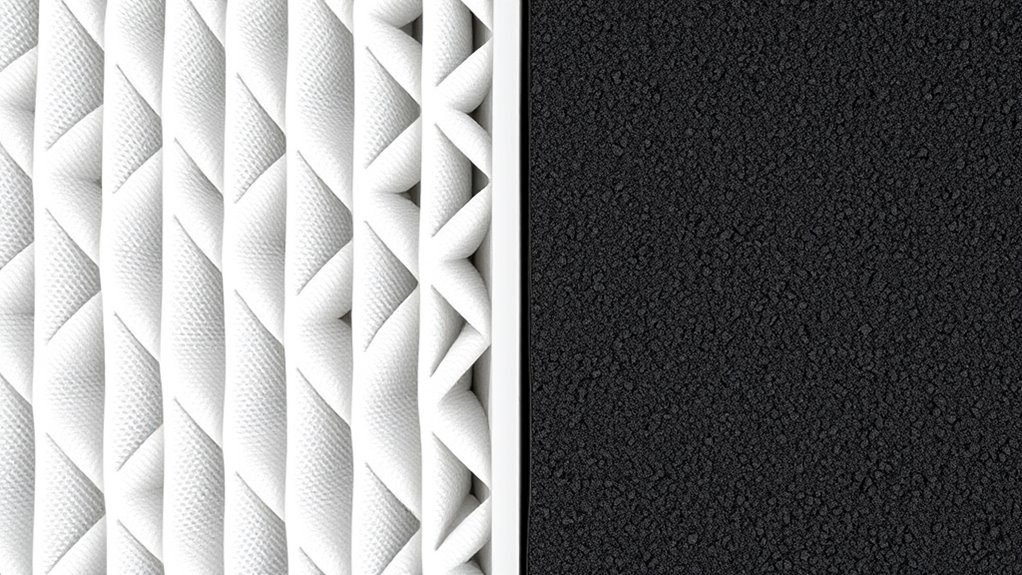
When comparing particle filtration and gas adsorption, you’ll notice that HEPA filters excel at capturing particles like dust and allergens, while activated carbon targets odors and chemical fumes. The size and material differences determine each filter’s strengths and limitations in removing specific pollutants. Combining both types provides a balanced approach for cleaner indoor air. Additionally, understanding the safety and precautions associated with each filter type ensures proper usage and maintenance. Proper filter replacement schedules are essential to maintain effectiveness and prevent mold or bacterial growth within the filters.
Particle Filtration Efficiency
How well a particle filter performs depends on its ability to physically trap or adsorb different types of pollutants. HEPA filters excel at capturing at least 99.97% of particles down to 0.3 micrometers, the most penetrating size, through diffusion, interception, and impaction. Efficiency slightly drops for smaller or larger particles but remains highly effective against pollen, mold, dust mites, viruses, and allergens. In contrast, activated carbon filters mainly adsorb gases and VOCs, capturing some particles by adsorption rather than mechanical filtration. Their particle removal is less reliable and secondary to gas removal. Additionally, world clock tools can help users monitor pollution levels across different regions, aiding in selecting appropriate air quality solutions. – HEPA traps particles mechanically, with high efficiency at 0.3 micrometers – Gases and odors pass through HEPA filters largely unaffected – Carbon filters adsorb ultrafine particles into porous surfaces – HEPA is better for solid particles, carbon for gaseous pollutants. Furthermore, advances in filter technology continue to enhance the performance and efficiency of both types of filters.
Gas Adsorption Capabilities
Activated carbon filters remove gases and odors primarily through adsorption, where pollutant molecules stick to the porous surface of the carbon granules. Unlike absorption, which involves pollutants permeating the material, adsorption keeps gases on the surface. The porous structure offers a large surface area—up to 500 m² per gram—enabling effective removal of VOCs, formaldehyde, benzene, ammonia, and smoke components. Adsorption occurs via physical forces or chemical bonds, allowing a broad range of gases to be neutralized. These filters don’t trap particles but excel at eliminating gaseous pollutants and odors, complementing HEPA filters. Porous structure plays a key role in maximizing the adsorption process, making it essential for effective gas filtration. Additionally, the efficiency of activated carbon can be enhanced by treatment methods that increase surface activity and adsorption capacity. However, their capacity is limited by saturation; they require timely replacement, typically every 12 to 15 months. Pelletized carbon provides more surface area, extending filter life and improving gas removal efficiency.
Size and Material Differences
Different filter materials are designed to target specific pollutants based on their size and structure. HEPA filters use densely packed fiberglass fibers to physically trap particles like pollen, dust, and bacteria through interception and diffusion. These fibers are microscopic and arranged in a maze-like pattern, slowing airflow and capturing solids efficiently. Understanding filtration mechanisms plays a crucial role in selecting the appropriate filter for specific pollutants. Activated carbon filters consist of treated carbon granules or pellets with a vast surface area, enabling them to adsorb gases, odors, and VOCs through chemical attraction. Unlike HEPA filters, they don’t trap particles but focus on gaseous contaminants. Understanding adsorption is essential to appreciating how carbon filters effectively remove gaseous pollutants without trapping particles.
Lifespan and Maintenance Requirements for Each Filter Type
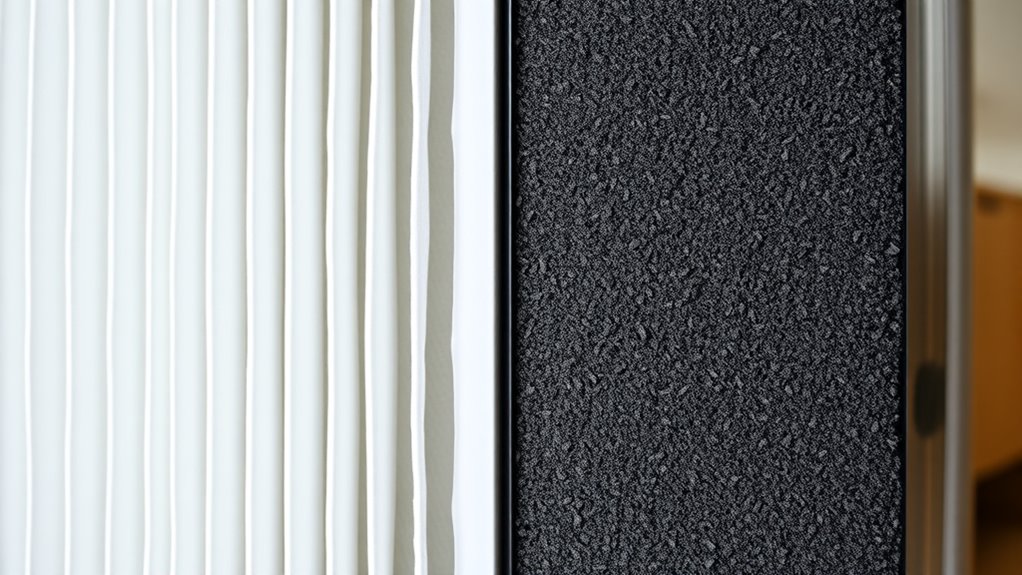
Understanding the lifespan and maintenance needs of air purifier filters helps guarantee peak performance and cost-effectiveness. HEPA filters typically last 6 to 12 months in homes, up to 2 years in HVAC systems, and sometimes longer in cleanroom environments with proper testing. Regular leak tests and cleaning of pre-filters extend their life, but washing HEPA filters is discouraged. Proper filter maintenance can significantly impact the efficiency and longevity of your air purifier. Activated carbon filters usually need replacement every 3 to 6 months, depending on pollutant levels and usage. They cannot be cleaned effectively and should be replaced when odors or chemicals reappear. Both filter types require scheduled replacements: HEPA filters every 6 months to 2 years, and activated carbon filters more frequently. Proper maintenance and timely replacements guarantee ideal air quality and filter efficiency. Additionally, understanding the content ownership rights associated with AI-generated content can help ensure compliance and protect your investments.
Typical Applications and Ideal Use Cases

HEPA filters are widely used across various settings to improve air quality by efficiently capturing airborne particles. You’ll find them in hospitals, cleanrooms, and pharmaceutical facilities, where maintaining sterile environments and reducing pathogens is critical. In homes, offices, and classrooms, they help remove dust, pollen, and pet dander to improve indoor air quality. HEPA filters are also essential for controlling airborne viruses like COVID-19, especially when combined with UV sterilization. In industrial settings, such as semiconductor manufacturing or food processing, they trap ultrafine particles to prevent contamination. Additionally, many air purifiers and HVAC systems incorporate HEPA filters to ensure continuous removal of particulates with at least 99.95% effectiveness. Understanding air filtration technologies can help in selecting the most appropriate system for specific needs. For optimal performance, filter maintenance is crucial to sustain their high efficiency and prolong their lifespan.
Material Composition and Filtration Technologies

The effectiveness of air purification depends heavily on the materials and technologies used within the filters. HEPA filters are made from randomly arranged fine fibers—like polypropylene, PTFE, or glass—forming mats that trap particles through sieving, diffusion, and interception. These fibers create convoluted pathways to catch pollen, dust, and even microbes. In contrast, activated carbon filters consist of porous carbon derived from coconut shells, coal, or wood, designed to adsorb gases, odors, and VOCs through their extensive surface area. Additionally, the filtration mechanisms vary significantly between the two types, influencing their suitability for different air quality concerns. The porous structure of activated carbon enhances its ability to trap larger molecules and chemical compounds more effectively.
Cost Considerations and Replacement Schedules
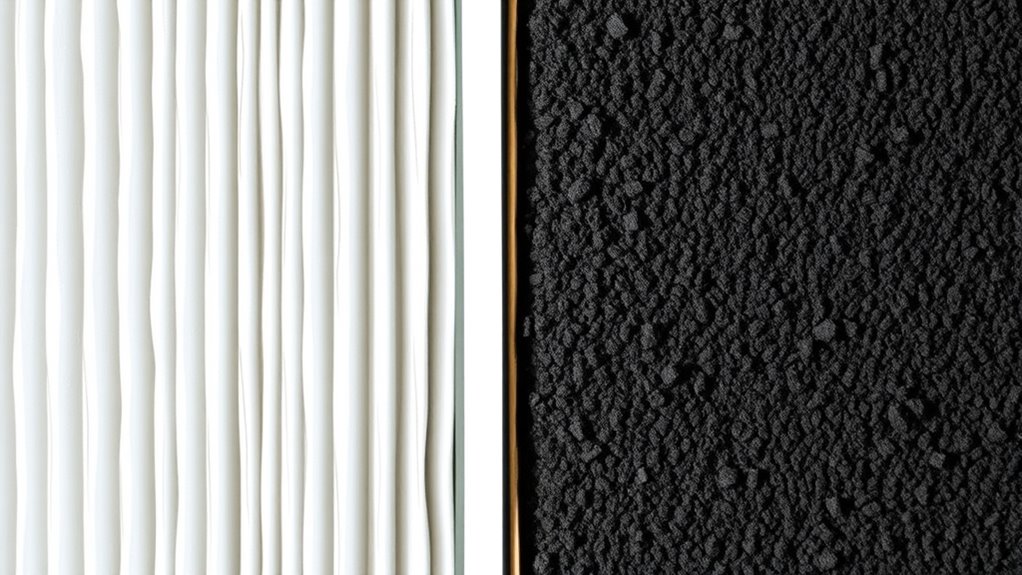
Choosing the right air purifier filter involves balancing initial costs with ongoing expenses, as replacement schedules considerably impact your long-term budget. HEPA filters typically cost between $18 and $100+, with mid-range options around $20-$70. Buying in bulk can reduce the per-unit price. Premium filters like True HEPA H13 may cost $50-$100+. Activated carbon filters, often part of multi-layer filters, usually cost $20-$30 and need replacement every 3-6 months. Some systems have separate carbon pre-filters, adding to maintenance costs. Keep in mind, HEPA filters generally last 6-12 months, while carbon filters need more frequent changes for maximum performance. Proper scheduling ensures efficiency and prevents airflow issues. Additionally, understanding filter lifespan can help you plan replacements more effectively.
Health Benefits and Safety Aspects
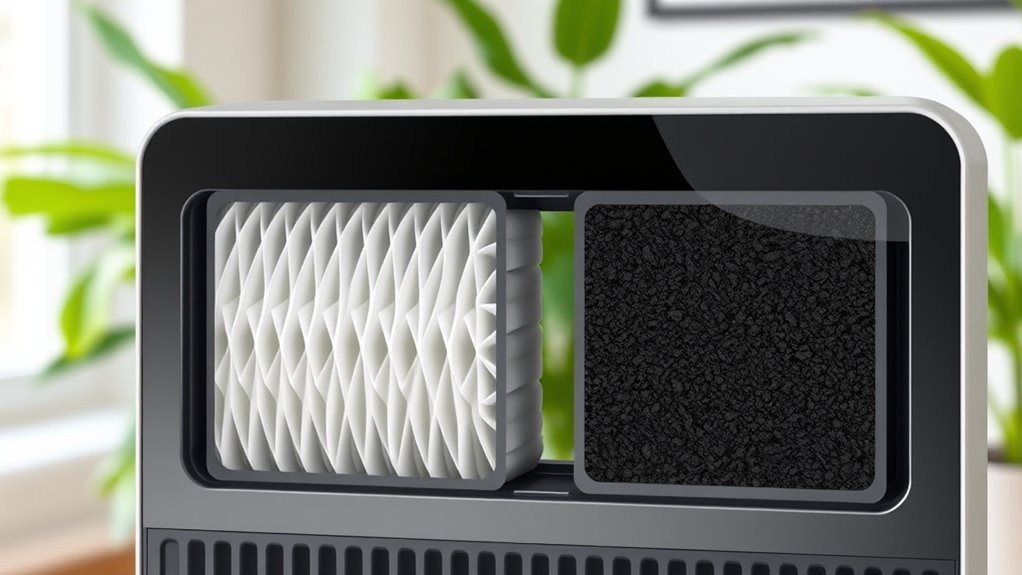
Air purifier filters play a crucial role in safeguarding your respiratory health by removing harmful airborne particles and pollutants. HEPA filters trap 99.97% of particles, including pollen, pet dander, mold spores, bacteria, and viruses, reducing allergy symptoms and asthma symptoms like coughing and wheezing. They also lower viral loads, decreasing the risk of respiratory infections. Activated carbon filters adsorb harmful gases, VOCs, odors, and chemical pollutants, especially those from cigarette smoke and household chemicals, making indoor air safer. While HEPA filters target particles, activated carbon handles gaseous irritants, providing thorough protection. Proper maintenance and timely filter replacement ensure safety and effectiveness, preventing secondary contamination. Using both filters together maximizes health benefits, reducing triggers and improving overall indoor air quality safely.
Combining Filters for Optimal Indoor Air Quality
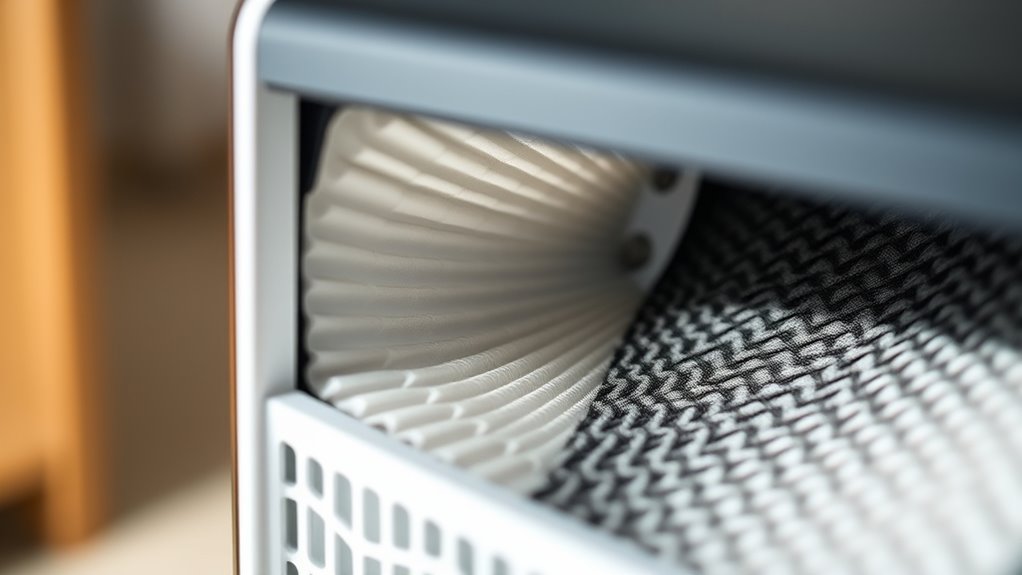
Combining HEPA and activated carbon filters enhances indoor air quality by addressing a wider range of pollutants simultaneously. You get the benefits of trapping airborne particles like dust, pollen, pet dander, and smoke with HEPA, while activated carbon adsorbs gases, odors, and harmful chemicals such as formaldehyde. This dual approach ensures thorough purification, tackling both particulate matter and gaseous contaminants. To maximize performance, use true HEPA filters paired with deep bed activated carbon for better adsorption. Incorporate washable pre-filters to extend filter life, and consider hybrid designs that balance airflow and noise. Proper maintenance and design choices help keep your air purifier efficient and quiet, ensuring cleaner, healthier indoor air.
Enhance indoor air quality with HEPA and activated carbon filters for comprehensive purification.
- HEPA traps particles like pollen and dust mites
- Activated carbon absorbs gases and odors
- Deep bed carbon extends adsorption capacity
- Hybrid designs optimize airflow and noise
Frequently Asked Questions
Can HEPA Filters Remove Airborne Viruses Effectively?
Yes, HEPA filters can effectively remove airborne viruses. They capture 99.97% of particles 0.3 microns or larger, including many virus-laden aerosols. While they don’t inactivate viruses, they trap most of them, reducing airborne transmission. Regular maintenance improves performance, and combining HEPA filters with other technologies, like UV-C or antiviral coatings, enhances overall virus mitigation. So, using a HEPA filter considerably helps clean indoor air from viruses.
Do Activated Carbon Filters Release Any Harmful Substances During Use?
A stitch in time saves nine, and thankfully, activated carbon filters generally don’t release harmful substances during use. They adsorb pollutants without emitting toxins, provided you follow proper maintenance and replace them when needed. Elevated temperatures or high humidity can cause some trapped chemicals to desorb, but under normal conditions, these filters are safe. Regular replacement guarantees they continue to improve your air quality without posing health risks.
Are There Filters That Combine HEPA and Carbon Functions in One Unit?
Yes, you can find filters that combine HEPA and activated carbon functions in one unit. These composite filters efficiently trap tiny particles and absorb gases, odors, and VOCs, offering thorough air purification. They’re designed for convenience, reducing maintenance and replacing just one filter. Brands like AQUAVI, Dyson, and InvisiClean provide such combined filters, ideal for allergy sufferers, pet owners, and those sensitive to chemicals, ensuring cleaner, healthier indoor air.
How Do Filter Sizes Affect Their Removal Efficiency?
You’ll find that smaller filter sizes tend to be less efficient at removing tiny particles, especially around 0.3 microns, because they have less surface area for trapping contaminants. Larger filters, especially thicker ones, improve efficiency by providing more surface for particle capture and maintaining better airflow. Consequently, choosing a bigger, thicker filter enhances removal of small, harmful particles, ensuring cleaner air and better overall filtration performance.
Can Electrostatic Filters Replace HEPA or Activated Carbon Filters?
You can’t fully replace HEPA or activated carbon filters with electrostatic filters. For example, if someone has severe allergies, electrostatic filters won’t trap tiny allergens as effectively. They’re great for dust and pollen but lack the ability to remove gases, odors, or VOCs that activated carbon handles. So, if you need thorough air cleaning, electrostatic filters alone aren’t enough—they’re better as a supplement, not a replacement.
Conclusion
Choosing between HEPA and activated carbon filters depends on what you need to remove from your air. HEPA filters excel at capturing tiny particles like dust and allergens, while activated carbon tackles odors and gases. Want the best of both worlds? Consider a filter system that combines both! After all, isn’t your health worth investing in the right air purification? Breathe easier knowing you’ve made a smart choice for your indoor environment.
